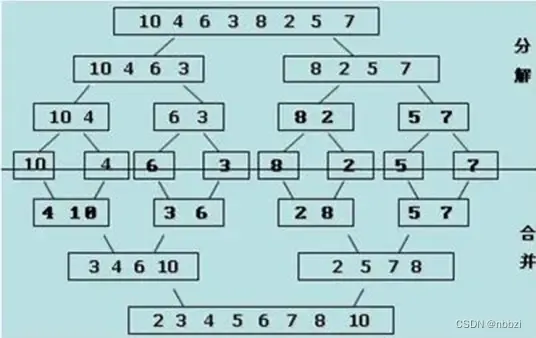目录
在Java中,链表可以使用一个节点类来实现。节点类中包含一个数据成员和一个指向下一个节点的指针。
归并排序
归并排序是建立在归并操作上的一种有效,稳定的排序算法,该算法是采用分治法(Divide and Conquer)的一个非常典型的应用。将已有序的子序列合并,得到完全有序的序列;即先使每个子序列有序,再使子序列段间有序。若将两个有序表合并成一个有序表,称为二路归并。
在Java中实现归并排序可以按照以下步骤进行:

-
创建一个用于归并排序的方法,接收一个整数数组作为参数:
public class MergeSort { public void mergeSort(int[] array) { if (array.length < 2) { return; } int middle = array.length / 2; int[] left = new int[middle]; int[] right = new int[array.length - middle]; for (int i = 0; i < middle; i++) { left[i] = array[i]; } for (int i = middle; i < array.length; i++) { right[i - middle] = array[i]; } mergeSort(left); mergeSort(right); merge(left, right, array); } } -
创建一个递归方法用于合并两个有序数组:
private void merge(int[] left, int[] right, int[] result) { int leftLength = left.length; int rightLength = right.length; int i = 0, j = 0, k = 0; while (i < leftLength && j < rightLength) { if (left[i] <= right[j]) { result[k++] = left[i++]; } else { result[k++] = right[j++]; } } while (i < leftLength) { result[k++] = left[i++]; } while (j < rightLength) { result[k++] = right[j++]; } } -
创建一个示例来测试排序方法:
import java.util.Arrays; public class MergeSortExample { public static void main(String[] args) { int[] array = {5, 3, 8, 4, 2, 1, 9, 7, 6}; mergeSort(array); System.out.println("Sorted array: " + Arrays.toString(array)); } public static void mergeSort(int[] array) { if (array.length < 2) { return; } int mid = array.length / 2; int[] left = new int[mid]; int[] right = new int[array.length - mid]; for (int i = 0; i < mid; i++) { left[i] = array[i]; } for (int i = mid; i < array.length; i++) { right[i - mid] = array[i]; } mergeSort(left); mergeSort(right); merge(left, right, array); } public static void merge(int[] left, int[] right, int[] result) { int i = 0, j = 0, k = 0; while (i < left.length && j < right.length) { if (left[i] <= right[j]) { result[k++] = left[i++]; } else { result[k++] = right[j++]; } } while (i < left.length) { result[k++] = left[i++]; } while (j < right.length) { result[k++] = right[j++]; } } }在Java中,链表可以使用一个节点类来实现。节点类中包含一个数据成员和一个指向下一个节点的指针。
以下是链表的基本操作的一个示例:
class Node { int data; Node next; public Node(int data) { this.data = data; this.next = null; } } class LinkedList { Node head; public void append(int data) { Node newNode = new Node(data); if (head == null) { head = newNode; } else { Node current = head; while (current.next != null) { current = current.next; } current.next = newNode; } } public void prepend(int data) { Node newNode = new Node(data); newNode.next = head; head = newNode; } public void delete(int data) { if (head == null) { return; } else if (head.data == data) { head = head.next; } else { Node current = head; while (current.next != null && current.next.data != data) { current = current.next; } if (current.next != null) { current.next = current.next.next; } } } public boolean isEmpty() { return head == null; } public void printList() { Node current = head; while (current != null) { System.out.print(current.data + " "); current = current.next; } System.out.println(); } } public class Main { public static void main(String[] args) { LinkedList linkedList = new LinkedList(); linkedList.append(1); linkedList.append(2); linkedList.append(3); linkedList.append(4); linkedList.printList(); // 输出: 1 2 3 4 linkedList.prepend(0); linkedList.printList(); // 输出: 0 1 2 3 4 linkedList.delete(2); linkedList.delete(4); linkedList.printList(); // 输出: 0 1 3 } } -
下面是Java中使用链表实现归并排序的示例代码:
-
class ListNode { int val; ListNode next; ListNode(int val) { this.val = val; } } public class MergeSortLinkedList { public static ListNode mergeSort(ListNode head) { if (head == null || head.next == null) { return head; } ListNode middle = getMiddle(head); ListNode nextOfMiddle = middle.next; middle.next = null; ListNode left = mergeSort(head); ListNode right = mergeSort(nextOfMiddle); return merge(left, right); } private static ListNode getMiddle(ListNode head) { if (head == null) { return head; } ListNode slow = head; ListNode fast = head; while (fast.next != null && fast.next.next != null) { slow = slow.next; fast = fast.next.next; } return slow; } private static ListNode merge(ListNode left, ListNode right) { if (left == null) { return right; } if (right == null) { return left; } ListNode result = null; if (left.val <= right.val) { result = left; result.next = merge(left.next, right); } else { result = right; result.next = merge(left, right.next); } return result; } public static void main(String[] args) { ListNode head = new ListNode(3); head.next = new ListNode(4); head.next.next = new ListNode(1); head.next.next.next = new ListNode(2); ListNode sortedList = mergeSort(head); while (sortedList != null) { System.out.print(sortedList.val + " "); sortedList = sortedList.next; } } }





















 434
434

 被折叠的 条评论
为什么被折叠?
被折叠的 条评论
为什么被折叠?








